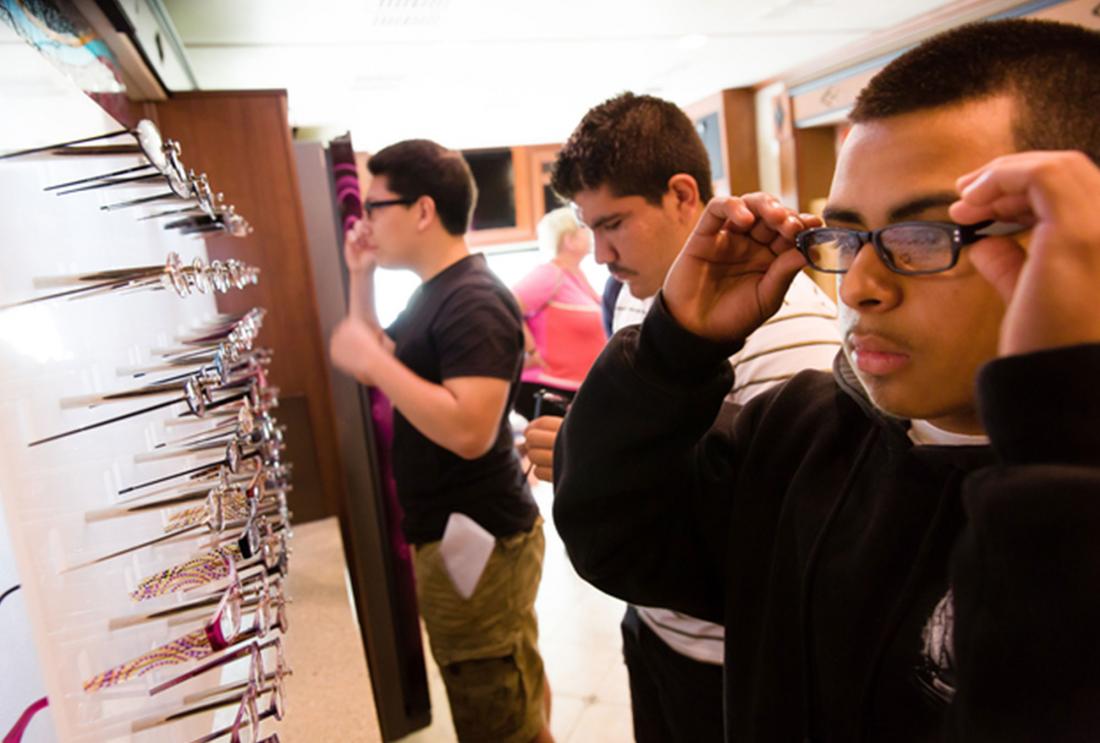Providing Vision Screening and Free Eyeglasses in Elementary Schools in the United States
- Students
- Enrollment and attendance
- Student learning
- In-kind transfers
More than 20 percent of all school-age children in the United States have vision problems. Low-income students and students of color are even more likely to have unmet vision care needs. Researchers evaluated the impact on educational outcomes of providing enhanced vision services to low-income elementary school children. Providing vision screening and free eyeglasses significantly increased achievement in two of the three districts studied, while screening without the provision of free eyeglasses had no effect.
Policy issue
A substantial percentage of school-age children in the United States, particularly low-income children and children of color, have unmet vision care needs, which may impair learning. Although common refractive errors can be corrected at relatively low cost with eyeglasses, affected children may not know that vision problems exist, may have inadequate access to vision follow-up services and eyeglasses, or may refuse to wear eyeglasses due to social stigma. Vision interventions have the potential to be a very cost-effective way to improve outcomes, especially for students facing the greatest barriers to learning. However, there is little evidence on the effectiveness of programs in the United States designed to treat unaddressed vision problems and what impact these programs may have in improving academic outcomes.
Context of the evaluation
The study occurred in 89 elementary schools eligible for Title 1 federal funding in three large school districts in central Florida. All schools in the study had at least 70 percent low-income students, far above the Title 1 threshold of 40 percent. Low-income and minority children have a greater than average risk of under-diagnosis and under-treatment of vision problems, as well as lower than average educational outcomes. Florida schools conduct basic vision screening for all children in kindergarten, 1st grade, 3rd grade, and 6th grade. Florida's Vision Quest (FLVQ), the implementing partner, is a non-profit organization that offers state-of-the-art screening, comprehensive vision exams and free eyeglasses for low-income children in central Florida.

Details of the intervention
Researchers conducted a randomized evaluation to test the impact of enhanced vision services on the educational outcomes of low-income elementary school children. Eighty-nine elementary schools eligible for Title 1 funding were randomly assigned to one of two intervention groups or a control group. In the 46 intervention schools, FLVQ offered screening to all 4th and 5th grade students with a state-of-the-art screening tool, which may be more accurate than the standard screening methodology. No such screening was provided at the control schools.
One-half of the intervention schools were “screen-only” schools and did not receive any services beyond the vision screening. Students who failed the screening were sent home with a note (in English or Spanish) indicating that they should follow up with a doctor of their choosing.
The remaining half of intervention schools were “full-treatment” schools, and each student who failed the screening was offered a free comprehensive vision exam at a mobile vision clinic at the student’s school. If the optometrist at the mobile vision clinic prescribed eyeglasses, the student would receive two pairs of eyeglasses delivered to the school at no charge.
The researchers used administrative data, including at least two years of reading and math scores on the Florida Comprehensive Achievement Test, attendance rates, and discipline records, from each school district to track the students’ educational outcomes.
Results and policy lessons
The study revealed a large proportion of students with untreated or undertreated vision problems. These students did not have significantly worse educational outcomes than students without vision problems, but did see academic gains from the full-treatment intervention.
Prevalence and Take-up: Approximately one in four students in the study sample had untreated or undertreated vision problems. Seventy-five percent of the students diagnosed with vision problems in the full-treatment schools took the necessary steps to receive a prescription for free eyeglasses. The remaining 25 percent of these students did not obtain the requisite permission form from their parents and/or did not attend school on the day(s) the mobile clinic visited their school. Students with vision problems did not have significantly lower test scores than students without vision problems.
Full Treatment Schools: In the two school districts that did not experience significant implementation issues, the full-treatment intervention increased the probability of passing the standardized reading test by 2.5 percentage points and the standardized math test by 3.4 percentage points (from a base of about 50 percent in both cases). Even when including the third district, there is suggestive evidence that the full treatment intervention improved reading test passage rates by 1.2 percentage points or about 0.03 standard deviations). Given a modest implementation cost of about $434 per classroom, the researchers suggest that the intervention may be quite cost-effective. The education gains from the intervention faded out within a year and a half for most students, which the researchers suggest may be due, in part, to students losing, breaking, or not continuing to wear their glasses. Follow up access to screening and free eyeglasses may alleviate the fade out.
Screen-Only Schools: The screen-only intervention had no significant effect, suggesting the greater importance of providing access to follow-up services and eyeglasses (as compared to merely diagnosing a student’s impaired vision) in remedying the untreated vision problems in the study sample.
